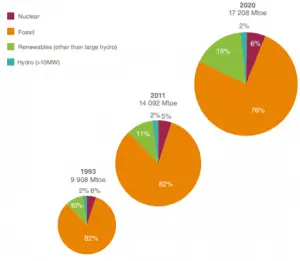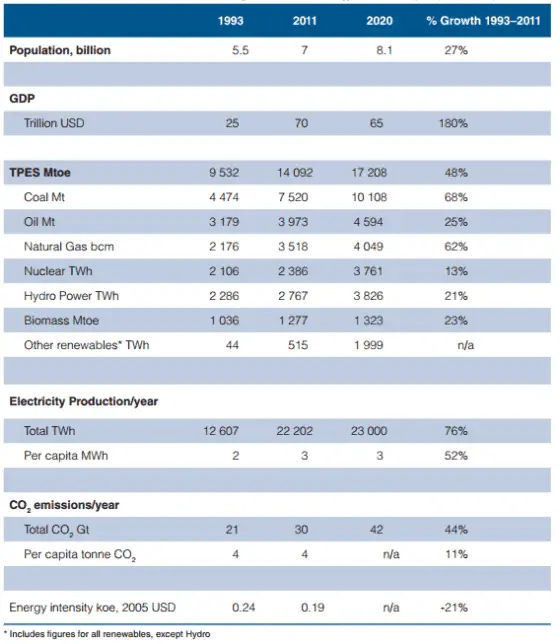Energy sources have always played a very important role in the development of human society. Since the industrial revolution, energy has been a driving force for modern civilization development. Technological development and consumption of primary energy and the increase of the world population are interdependent. In the past 20 years, the world around us has changed significantly. Technology has become one of the main drivers of economic and social development. The rapid advancement of Information Technology (IT) worldwide has transformed the way we think and the way we act. It must be noted that practically all technologies run on electrical energy. Therefore, the share of electricity is increasing rapidly, faster than Total Primary Energy Supply (TPES – the sum of production and imports subtracting exports and storage changes.).

Source: World Energy Resources – 2013 Survey
Used by permission of the World Energy Council
At present, fossil fuel is still the world’s predominant energy source. Its extraction, production, and use are not considered efficient regardless of the new technologies available to improve its use and extraction. When studying energy resources, we have to distinguish the primary energy sources and secondary energy sources.
Primary Energy Sources

Source: World Energy Resources – 2013 Survey
Used by permission of the World Energy Council
Primary energy (PE) is an energy resource found in nature that has not been subjected to any conversion or transformation process. It is the energy contained in raw fuels and other forms of energy received as input to a system. Primary energy sources take many forms, including nuclear energy, fossil energy — like oil, coal, and natural gas — and renewable sources like wind, solar, geothermal, and hydropower. These primary sources can be converted to secondary energy sources, so-called energy carriers. Primary energy sources can be divided into:
- Non-renewable sources
- Fossil fuels
- Oil
- Coal
- Natural gas
- Mineral fuels
- Natural Uranium
- Natural Thorium
- Fossil fuels
- Renewable sources
- Solar energy
- Wind energy
- Hydro and tidal energy
- Geothermal energy
- Biomass energy (if sustainably exploited)
Secondary Energy Sources – Energy Carriers
Secondary energy sources, also called energy carriers, are derived from the transformation of primary energy sources. They are called energy carriers because they move energy in a useable form from one place to another. The well-known energy carriers are:
- Electricity
- Petrol
- Hydrogen
Electricity and hydrogen are made from primary energy sources such as coal, natural gas, nuclear energy, petroleum, and renewable energy sources. Electricity is particularly useful since it has low entropy (is highly ordered) and can be converted into other forms of energy very efficiently. We cannot say that hydrogen has the potential to offset fossil fuels.
Secondary energy sources are used because their use is easier than using a primary energy source. For example, using electricity for lighting is safer than using petroleum in candles or kerosene lamps.
On the other hand, any conversion of primary energy to energy carrier is associated with some inefficiency. Therefore, when dealing with the secondary energy source, we always consider how the carrier was made.
Examples of Energy of 1 Joule
One joule in everyday life and science corresponds to approximately:
- The kinetic energy of an object with mass 1 kg moving at √2 ≈ 1.4 m/s.
- The kinetic energy of a 50 kg object (e.g.,, human) moving very slowly – approximately 0.72 km/h.
- The energy required to lift a medium-size apple (100 g) 1 meter vertically from the surface of the Earth.
- The heat required to raise the temperature of 1 g of water by 0.24 °C.
- The heat required to evaporate of 0.00044 g of liquid water at 100°C.
- The amount of electricity required to light a 1 watt LED for 1 s.
- Is released by approximately 3.1⋅1010 fissions in a nuclear reactor.